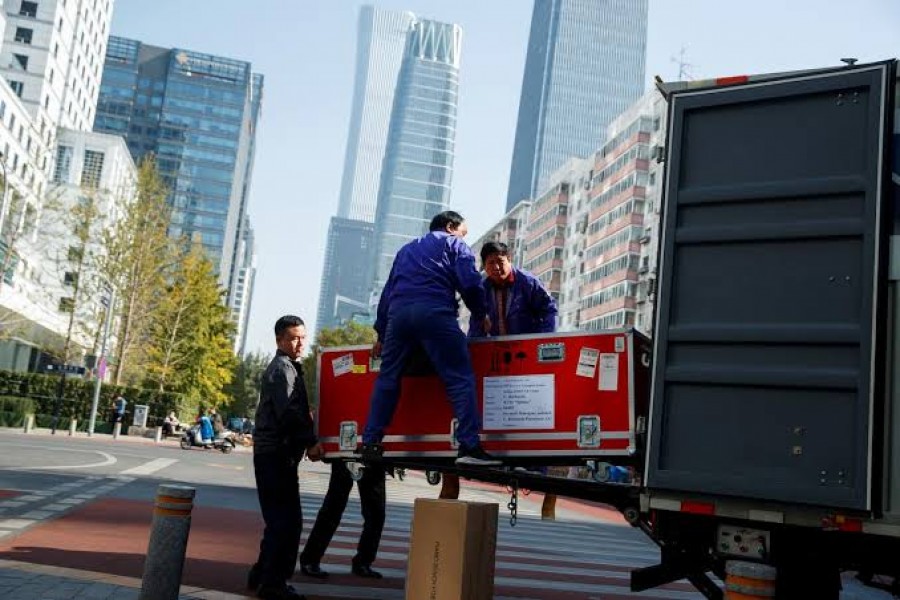Annual profits at China’s Ningbo S-Power International Logistics Co are down a sharp 40 per cent year-on-year, and export orders have also fallen at a similarly dizzying rate.
The firm’s woes highlight a bigger problem for the world’s second-largest economy and its stability-obsessed leaders - the intensifying pressure on employment as a structural slowdown in the once-booming services sector is exacerbated by the protracted Sino-US trade war.
The simultaneous downturn in the services and manufacturing industries poses a daunting challenge for authorities seeking to keep a lid on unemployment and prevent social unrest as economic growth slumps to near three-decade lows.
“The employment problem is rising as the services sector is slowing,” said a policy insider who advises the government.
The worries are palpable as services firms have been the shock absorber in China’s labour market, creating more new jobs to offset rising factory layoffs, but increases in US tariffs are starting take a toll on logistics, shipping, transport and storage firms, , says a Reuters report.
China’s survey-based urban jobless rate climbed to 5.1 per cent in October from 4.9 per cent in April 2018, when the United States and China began imposing tit-for-tat import tariffs, official data showed. Analysts have long been skeptical about the reliability of the employment numbers.
Mei Zhenhua, a manager at the logistics concern Ningbo S-power, which is based in eastern Zhejiang province, told Reuters the firm’s profits and export orders have taken a tumble this year.
“If our customers face difficulties due to the higher (US) tariffs, they may cancel their orders,” Mei said.
“Orders have fallen by about 40 per cent and profits have dropped by a similar margin.”
Hao Yao, a manager at Yingsheng Global Logistics Co in Shenzhen in southern Guangdong province - China’s export powerhouse - said company profits have been slashed by nearly a third this year with clients hit by the trade war.
Executives at other export-related services firms painted a similar downbeat picture, with some considering cutting jobs or lowering wages if business conditions deteriorate further.
“The employment pressure is rising amid the trade war, that’s why the government has attached greater importance to job-creation,” said a second policy insider.
PRESSURE ON SERVICES, JOBS
Logistics, transport and storage firms account for about a third of the services economy. Other segments of the sector are also feeling the heat, with retailers struggling as consumers cut spending, shadow lenders hurt by a deleveraging campaign. Even the once high-flying technology sector is losing steam.
The numbers are telling.
China’s services activity expanded at its weakest pace in over three years in October, according to an official survey, while a private survey showed growth hit a eight-month low.
Annual services output growth of 7.2 per cent in the third quarter was near the weakest level since the global financial crisis.
Little surprise then that the slowdown in the nation’s vast services sector is stoking employment worries given its vital role in job-creation, policy insiders and analysts said.
China’s most recent quarterly Beige Book report in September underlined just why authorities might be anxious, saying that “if manufacturing does have to shed a large number of jobs, services has shown no capacity to absorb them.”
Economists at UBS estimated that a 5 per cent drop in China’s value-added exports could lead to an overall loss of 3 million jobs. Some Chinese analysts estimate that the trade war may have affected around 4 million jobs.
Beijing is struggling to create relatively high-paying jobs for over 8 million college graduates each year, analysts said. Still, a shrinking pool of workers due to China’s demographic changes, alongside government subsidies for companies to discourage job cuts could prevent a sharp rise in unemployment, they said.
China economic growth cooled to a near 30-year low of 6 per cent in the third quarter, and analysts don’t expect an interim trade deal to brighten the outlook anytime soon as the tariff war has only exacerbated a slowdown caused by weaker domestic demand.
The trade sector is far from out of the woods either, with exports contracting for a third month in October, albeit at a softer than expected pace. And data on Thursday showed industrial output grew significantly slower than expected last month.
MORE STIMULUS ON CARDS
The rising pressure on growth will see policymakers rolling out more stimulus to ward off a deep economic slump, although the room for aggressive policy action has been limited by worries over debt and housing risks, policy insiders said.
“There is definitely room for fiscal policy – we can expand budget deficit next year - although the room for monetary policy is not big,” one of the insiders said.
The government has raised this year’s budget deficit to 2.8 per cent of GDP from 2.6 per cent in 2018.
Beijing has been leaning more heavily on fiscal stimulus to weather the current downturn, announcing 2 trillion yuan ($286 billion) in tax and fee cuts this year and 2.15 trillion yuan in special local government bond issuance to finance infrastructure projects.
The central bank has cut reserve requirements seven times since early 2018, in a bid to spur bank lending. On Tuesday, it cut the interest rate on its medium-term lending facility for the first time since early 2016.


